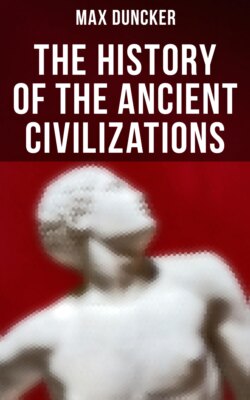Читать книгу The History of the Ancient Civilizations - Duncker Max - Страница 40
На сайте Литреса книга снята с продажи.
FOOTNOTES:
Оглавление[630] Exod. xv. 1–11; cf. Joshua xxiv. 7.
[631] Nöldeke, "Untersuchungen," s. 40.
[632] Exod. i. 1–7, 13, 14; ii. 23, 24; vi. 2–7, 9–27; vii. 8–13, 19–22; viii. 1–4, 12–15; ix. 8–11; xii. 1–23, 37, 40–51; xiii. 20; xiv. 8, 9, 15–17, 21–23, 29.
[633] Exod. xiii. 2; xxii. 29, 30; xxxiv. 19, 20. "The firstborn of thy sons thou shalt give to me. Likewise shalt thou do with thine oxen, and thy sheep. All that openeth the matrix is mine, all thy cattle that is male. All the firstborn of thy sons thou shalt redeem." Cf. Exod. xxx. 11–16.
[634] Ewald, "Alterthümer des Volkes Israel," s. 358 ff.
[635] De Wette-Schrader. "Einleitung," s. 282, 284, 290.
[636] Lepsius, "Briefe," s. 46, 47.
[637] Ebers. "Durch Gosen." s. 101 ff.
[638] Nöldeke. "Untersuchungen," s. 47. According to De Wette-Schrader, from the second text ("Einleitung," 283), verses 11–17 may be an addition; verses 19–21 obviously come from the revision.
[639] Exod. ii. 19.
[640] Büdinger ("Akad. d. Wissenschaft zu Wien," Sitzung vom, 15 October, 1873) regards Moses and Aaron as of Egyptian origin, as Egyptian priests, and finds the tribe of Levi in the leprous Egyptians who went out with the Hebrews. Lauth ("Moses der Hebraeer," and "Zeitsch. d. d. M. G." 1871, s. 135 ff) inclines to recognise Moses in the mohar, sotem (scribe) and messu of the papyrus Anastasi I., who would thus have been one of the Egyptian scholars, and employed by Ramses II. in matters of state and war. This view is opposed by Pleyte ("Zeitschr. f. aeg. Sprache," 1869, s. 30, 100 ff.); he reads the name Ptah-messu. Lauth, at the same time, refuses to derive the name Osarsiph from Osiris; he considers it to be Semitic, and explains it as a-sar-suph, i.e. "rush-basket."
[641] Lepsius, "Königsbuch der Ægypten," s. 117–150. Maspero objects that Egypt in the time of Menephta was still too powerful for the Israelites to carry out their exodus. Such a plan was possible for the first time in the last years of Sethos II. (above, p. 150), or shortly after his death ("Hist. Ancienne," p. 259). These considerations are of too general a nature to allow any definite conclusions to be founded upon them; and if Josephus or his copyist changed the Menephtes of Manetho into the much better known Amenophis, or mistook one for the other, a similar interchange cannot so easily be assumed for the names Sethos and Menephtes.
[642] Gen. xxxvi. 31–39; Nöldeke, "Untersuchungen," s. 87.
[643] Diod. 40, frag. 3.
[644] Diod. 34, frag. 1.
[645] Strabo, p. 760, 761.
[646] Fragm. 30, ed. Müller.
[647] Justin. "Hist." 36, 2.
[648] Joseph. "c. Apion." 1, 34.
[649] "Hist." 5, 2–5.
